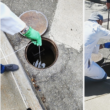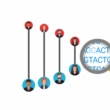Making bad data good
By Maria José Espona, April 11, 2014
Outbreaks of emerging pathogens, whether natural or manmade, are not just health issues. They present challenges along several other dimensions—legal, political, economic, and military. Improved disease surveillance is at the heart of meeting many of these challenges.
Disease surveillance entails gathering information about the current and past prevalence of diseases in specific countries and regions and provides context necessary for understanding new disease outbreaks and determining, among other things, if they are natural or manmade. Such information is gathered, for the most part, by national health organizations, which forward it to entities such as the World Health Organization, the Pan American Health Organization, and the Centers for Disease Control and Prevention. There, information is compiled into databases and published. But it's not always good information.
I have worked closely with disease statistics for more than a decade. Sadly, I have found that information about disease prevalence, whether in the developed or developing worlds, often contains discrepancies. For example, Argentina, Brazil, and Bolivia were reporting cases of dengue fever some years ago at a time when Paraguay was not. From a geographical and disease-transmission perspective, this was impossible. The discrepancy was not resolved until Paraguay provided updated numbers.
Faulty disease statistics are quite troubling in a world where international travel is easy and controls on passenger health are loose. They are troubling because urbanization has created very poor areas where crowding, inadequate hygiene, and low-nutrition diets allow diseases to flourish. Inaccurate statistics also represent a major impediment to national initiatives in both public health and defense. If you cannot say with confidence which diseases exist in your country, how can you develop a strategic plan to fight disease? How can you gauge the impact of diseases on your population? How can you prevent malevolent individuals from doing harm with deadly pathogens? Better data about the prevalence of disease are also essential for helping researchers perform their jobs more effectively and fulfilling commitments to instruments such as the Biological and Toxin Weapons Convention. If more effective systems for disease surveillance are to be established, improvements are necessary in two main areas: the legal and institutional realm, and the educational realm.
An international legal and institutional framework already exists for emerging diseases, comprising a health component and a weapons component. On the health side, the World Health Organization oversees efforts to combat many diseases. On the weapons side, the Biological and Toxin Weapons Convention, the Geneva Protocol, and the Australia Group (an informal export-control entity) are intended to inhibit the development of biological weapons. But there is considerable overlap between the two realms—for example, yellow fever and dengue fever are relevant both to the health side and the weapons side. This leads to much duplicated effort, as individuals and institutions responsible for disease reporting often must report data to multiple entities. Thus the odds increase that data discrepancies will appear. These problems could be remedied if international health and weapons institutions came to regard disease surveillance as a natural point of contact between their respective endeavors.
But no matter how close the coordination might be between health-oriented and weapons-oriented organizations, data on disease outbreaks will remain flawed if—as is often the case—local health professionals lack the education and training they need to fulfill their duties in disease surveillance. Nations and individual health professionals sometimes lack the ability to identify diseases. Sometimes they don't clearly understand which diseases to report, or whether to report individual cases or only major outbreaks. They may be unsure whether to report all cases or only fatalities. And there may be confusion about whether reports should be filed yearly, monthly, or whenever a worrisome event occurs.
The good news is that these problems can be resolved through improved education for health professionals and officials. The bad news is that little is being done at the international or national levels to improve education. Entities such as the World Health Organization should develop educational programs to address these problems, monitor their performance, and coordinate their efforts with related national initiatives. But bottom-up efforts can also be useful. For example, the University of Bradford has developed excellent tools that can be used to train health care professionals on issues such as reporting data to the Biological and Toxin Weapons Convention. Creating a world safer from emerging pathogens requires that players at all levels—from municipal to national governments, and from regional organizations to global ones—do their part to improve systems for disease surveillance and reporting.
Topics: Biosecurity
Share: [addthis tool="addthis_inline_share_toolbox"]














